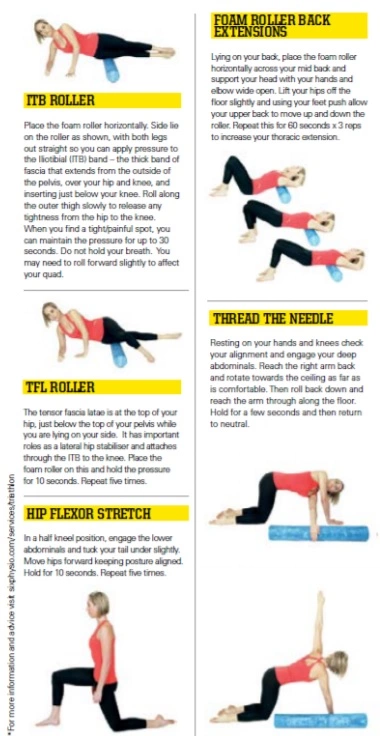Fiona Troup shares her expertise on why flexibility is important in all disciplines of triathlon TriahlonPlus Physio Corner Feb 16
Adequate flexibility is important for all disciplines of the triathlon to allow full range of movement for the required tasks and to optimise muscle function. If muscles are too stiff then this can impact on force and power production, (and ultimately performance!), as well as place undue strain and load across the joints due to increased compressive forces, with the risk of dreaded over-use type injuries. Stiffness will also impact on you posture throughout the day. It is also very important that your body has sufficient flexibility to comfortably achieve correct alignment.
It is important to understand that flexibility is only useful if you can control it well and move efficiently with the range of movement available. As with most things, the key is to achieve balance in the relationships between different muscle groups, as the body works in an orchestrated fashion where timing and interplay are critical. Over stretching and incorrect techniques of stretching can also lead to an increased incidence of soft tissue injuries in athletes. However, certainly, we see in practice that many people are stiff in some areas and too mobile in others, and other people can have more widespread stiffness, so it becomes critical to prescribe flexibility work appropriately.
There are many different thoughts and opinions as to how best improve flexibility, but most importantly, it needs to be applied appropriately to individual body types. Some people are natural very flexible or hypermobile and they actually need to focus more on their control of movement and conditioning aspects, and less on stretching. Often overloaded tissues feel like they need to be stretched but in actual fact may benefit from offloading, followed by conditioning work to restore the muscle function. Generally speaking more dynamic versions of stretching and mobilizing tissues can be more helpful than static stretching.
Foam rollers are hugely popular and are a great self-release tool that works similarly to a deep tissue massage, or myofascial release. They enable you to release the tightness to allow both the flexibility to improve, and can help the facilitate correct activation of the required muscles by switching off dominant patterns of over activity, allowing the weaker/inhibited muscles to become more involved. This is positive for improving both quality of movement and force/load distribution.
The swimming action requires flexibility particularly in their shoulders, triceps, chest, upper back and ankles. Stiffness in any of the areas of the upper body can lead to rotator cuff issues (swimmers shoulder), so it is vital to have a balanced program of dynamic mobility for the upper body, and to have a fluid range of point (plantar flexion) in the ankles.
Often runners have restricted flexibility of their hips and ankles, and cyclists often have stiff hips and mid backs. Stiffness in the hips and mid back can be a predisposing factor for low back pain as they can cause an excess of movement in the low back over time.
Yoga and Pilates can both be helpful to support your training program provided they are well taught and tailored to your body requirements, preferably in small classes or 1:1 sessions. If you are hypermobile care needs to be taken to not over stretch in this style of class.

